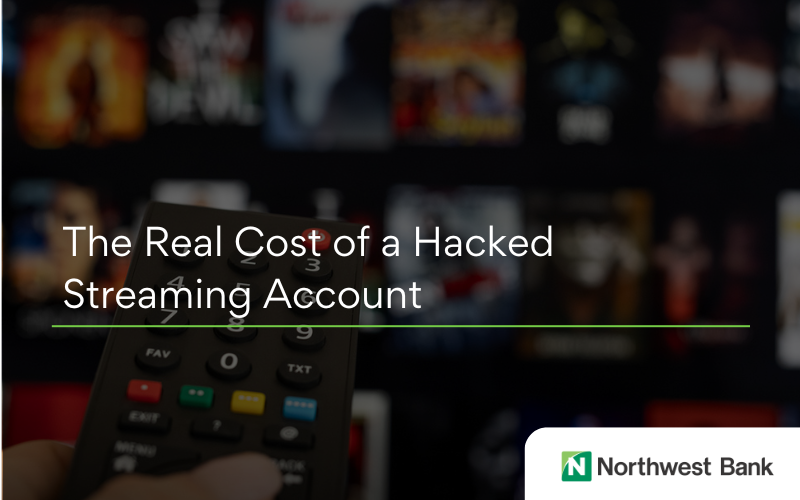How To Build Your Emergency Fund and Use It Wisely
How To Create Financial Security With An Emergency Fund
Everything you need to know to build your financial safety net.
Key takeaways:
- An emergency fund is a cash buffer to help you cover unexpected expenses, as well as temporarily replace your income in case of job loss.
- The best way to build your fund is to save a manageable portion of each paycheck — but you may ultimately aim to save up to six months’ worth of your salary.
- You can help accelerate your savings by sticking to a budget, looking for “hidden” opportunities to save and by making a savings plan with a banker.
Ever heard of the saying “hope for the best, plan for the worst”? That’s true for many things in life, including managing your money.
“Nobody likes to experience an emergency, but unfortunately, we all do one time or another,” says Kregg Heenan, District Manager overseeing Northwest Bank’s Erie, PA financial centers. “Having financial peace of mind makes the process easier and less stressful to get through the difficult times.”
And, thankfully, it’s probably easier than you think to protect yourself against financial emergencies. Read on to learn how an emergency fund can build financial security, plus tips and strategies to reach your savings goals.
First, what is an emergency fund?
An emergency fund, sometimes called a rainy day fund, is cash you keep on hand to provide an added layer of security. Unlike your retirement fund, vacation savings or other goal-oriented savings accounts, an emergency fund doesn’t have a single designated purpose — it’s simply there so you have cash when you need it.
You might dip into your emergency fund if your car breaks down and you need unexpected repairs, for example, or if you get a surprise medical bill. Your emergency fund can also provide a cash buffer to help you cover your expenses if you — or another member of your household — is laid off or if you have your hours or salary cut.
Who needs an emergency fund?
Everyone needs an emergency fund, says Heenan. “We are all vulnerable to emergency situations and when they occur, you want to make sure you have enough liquid and accessible funds to be able to cover that moment.”
Even if you aren’t responsible for your living expenses, an emergency fund can help cover unexpected bills or maintenance. And if you have other assets — for example, investments in a brokerage account — you’ll still need an emergency fund as well.
Do you need an emergency fund if you have a Home Equity Line of Credit (HELOC)?
Absolutely. While a HELOC also helps you access cash when you need it, it’s not intended to double as an emergency fund. “With a HELOC, your emergency time frame might be longer than the draw period or payback period of the HELOC,” says Heenan. “In addition, if you are able to cover your emergency with cash, you will not need to be concerned with a variable interest rate on the HELOC.”
- Pro tip: While your HELOC shouldn’t be used for emergency expenses, it can help you achieve other goals. Learn how to make the most of your home equity.
How much should you save in your emergency fund?
It depends who you ask. “Some experts recommend saving three to six months’ worth of your salary, while others recommend three to six months of expenses,” Heenan explains. The best approach is to set a goal that suits your financial situation. If you’ve already saved six months’ of expenses, start working toward six months’ of your salary, he recommends.
But what if you’re just getting started and three months of expenses is too big a goal?
Set a goal that works for your budget today, Heenan advises, and start contributing to your emergency fund every time you get paid to start building your nest egg. You can increase your goal gradually as your income increases and as you get more comfortable saving.
How to start building your emergency fund
Heenan recommends these five tips to start working toward your goal.
1. Open a savings account
The first step is simple: Open an account to store your emergency savings. Even if you have other savings accounts, a separate emergency fund makes it easier to keep track of your progress — and make sure you don’t accidentally spend your emergency savings on something else.
Emergency savings are best stored in a savings account or a money market account because these accounts let you access your money whenever you need to. Plus, unlike investment accounts, your balance won’t fluctuate based on market performance.
- Pro tip: The higher the interest rate on your emergency fund, the more your savings will grow over time. Learn how interest works with a savings account.
2. Create a budget
As the cost of living continues to soar, it’s important to use a budget to help you use each dollar to reach your goals. Your budget shouldn’t feel restrictive, but it should create room to set aside a portion of each paycheck for emergencies.
- Read more: How to start and sustain a budget that works
3. Look for sneaky ways to save
In addition to regular savings, there are plenty of ways to build your rainy day fund without feeling deprived, including:
- Saving a portion of lump sum payments, like an income tax refund, annual bonus or inheritance.
- Using your credit card rewards to power your savings. Cash-back credit cards issue cash on a percentage of your purchases, which you can use to top up your emergency fund.
- Pick up a side gig and funnel the extra income into your emergency fund until you reach your goal.
Maintain your current standard of living after a raise — at least temporarily. Using the extra income to boost your emergency fund helps you build financial security without tightening your budget.
4. Revisit your goals (semi-)regularly
The beauty of an emergency fund is that it’s there when you need it — and once you’ve reached your savings goal, you won’t need to revisit your strategy too often. However, it is worth checking in on your fund once a year or after significant life events.
Your annual check-in gives you an opportunity to adjust your emergency savings for inflation. While you’ll earn interest on the money in your account, it may not keep pace with inflation — and topping your fund up annually helps ensure it still provides the security you need.
It’s also a good idea to revisit your savings goal when your income or expenses change. If you upgrade your home or vehicle, for example, you may need a bigger emergency fund to account for your added monthly expenses. Similarly, if you get a raise, you might store a little extra in your emergency fund until your savings reflect three to six months of your current income.
5. Get help from the experts
Building an emergency fund can feel intimidating, especially if you’re new to saving. Speaking to a banker can make the process manageable so you’re excited — not anxious — about your goals.
A banker can work with you to find the best account to store your emergency fund, help you create a budget that you can happily stick to and offer financial advice tailored to your unique situation. Plus, a banker can help you navigate financial difficulty — so if you need to use your emergency fund, you can make it last as long as possible.
When you’re ready, we’re here to help you find peace of mind with a financial plan that works for you. To get started, find a Northwest Bank location near you.



